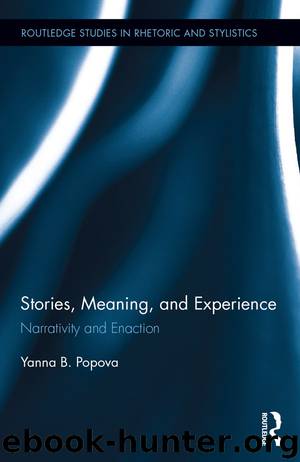Stories, Meaning, and Experience by Popova Yanna B

Author:Popova, Yanna B. [Yanna B. Popova]
Language: eng
Format: epub
Publisher: Taylor and Francis
3. Metaphor in Thought and Language
The use of metaphor comes naturally and effortlessly to every person engaged in human verbal and non-verbal interaction.5 In fact, the act is as effortless for human beings as telling a story. We make ample use of metaphor (“He is a fox in business”) in everyday speech, we regularly use proverbs (“A wonder lasts but nine days”) to make a point about a life experience, and we even understand whole narratives as being about something else than what is literally narrated (John Bunyan’s The Pilgrim’s Progress is not about the individual journey of a man called Christian but about the road to salvation of every man). Rather than being a special trait restricted to poetic usage, figurality is now believed to be part and parcel of our everyday thought and expression. This new and changing status of metaphor has in turn transformed the way it has been traditionally studied and described. While historically the domain of linguists, rhetoricians, philosophers, and literary scholars, more recently the study of metaphor and figurality has become a hot topic in the study of human cognition. Metaphor is based on a non-literal analogical relation between two entities (words or concepts) that serves to highlight some similarity between them. The word itself has Greek and Latin origins and means “transfer” or “carrying over” of meaning.6 Metaphor is particularly abundant in literary and poetic discourse (“Life is a broken-winged bird that cannot fly”, “All the world’s a stage”) but is also widely present in everyday language (“smooth voice”, “break the silence”).
One central question in research on metaphor has always been how to differentiate what is literal from what is metaphorical, and this very question has been answered in quite distinct ways by placing emphasis on the linguistic (communicative) versus the cognitive (conceptual) nature of figurality.7 Thus, very broadly speaking, it can be said that there are three groups of approaches to studying metaphor. The first two study metaphor as linguistic form, while the third considers it a cognitive mechanism. The first, semantic, view (Cohen, 1979) takes meaning to be truth-conditional and compositional, so that a metaphor like “Sally is a block of ice” is understood as semantically anomalous: it is both literally false and literally meaningless. This alerts the interpreter to the possibility that the sentence is to be understood as a metaphor. The second, pragmatic, view (Searle, 1979) takes meaning to be a matter of communicative intention and distinguishes between direct (explicit meaning) and indirect (implicit meaning). Metaphor, in this view, becomes a matter of recognizing the implicit meaning in a communicative situation. Both semantic and pragmatic theories rely strongly on an intrinsic distinction between literal and figurative meaning. The third, conceptual (cognitive), approach to metaphoric meaning (Gibbs, 1994; Lakoff and Johnson, 1980) proposes a radically different view of figuration as a matter not of linguistic expression alone but as a matter of thought. This view has been formulated in a number of different ways by various researchers and, despite its most recent and prominent association with cognitive linguistics, has a long history predating it.
Download
This site does not store any files on its server. We only index and link to content provided by other sites. Please contact the content providers to delete copyright contents if any and email us, we'll remove relevant links or contents immediately.
4 3 2 1: A Novel by Paul Auster(12283)
The handmaid's tale by Margaret Atwood(7679)
Giovanni's Room by James Baldwin(7191)
Asking the Right Questions: A Guide to Critical Thinking by M. Neil Browne & Stuart M. Keeley(5635)
Big Magic: Creative Living Beyond Fear by Elizabeth Gilbert(5610)
Ego Is the Enemy by Ryan Holiday(5294)
The Body: A Guide for Occupants by Bill Bryson(4974)
On Writing A Memoir of the Craft by Stephen King(4863)
Ken Follett - World without end by Ken Follett(4645)
Adulting by Kelly Williams Brown(4487)
Bluets by Maggie Nelson(4473)
Eat That Frog! by Brian Tracy(4435)
Guilty Pleasures by Laurell K Hamilton(4360)
The Poetry of Pablo Neruda by Pablo Neruda(4039)
Alive: The Story of the Andes Survivors by Piers Paul Read(3968)
White Noise - A Novel by Don DeLillo(3954)
Fingerprints of the Gods by Graham Hancock(3942)
The Book of Joy by Dalai Lama(3899)
The Bookshop by Penelope Fitzgerald(3775)
